Reproduction is one of the most important topics in the class 10th biology, chapter “How do organisms Reproduce”. Reproduction is a biological process by which organisms create new individuals of the same species. Reproduction can be either sexual, involving the fusion of gametes (sperm and egg cells), or asexual, where offspring are produced without the involvement of gametes.
Reproduction Definition
Organisms reproduce through different methods: Sexual and Asexual. Sexual reproduction involves two parents, each contributing specialized sex cells (sperm and egg), resulting in genetic diversity. Asexual reproduction requires only one parent and includes methods like binary fission, where the parent divides into two; budding, where an outgrowth forms a new individual; and fragmentation, where parts of the parent grow into new organisms.
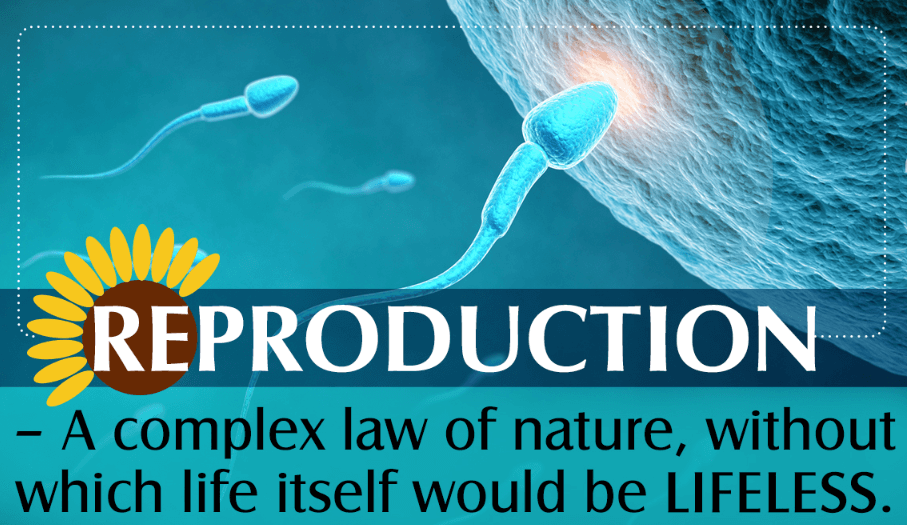
Some animals internally fertilize by depositing sperm inside females, while others, like fish, practice external fertilization, releasing eggs and sperm into the environment. Some organisms, hermaphrodites, possess both male and female reproductive organs. Reproduction methods vary due to an organism’s environment, evolution, and ecological role, ultimately contributing to life’s remarkable diversity.
Types of Reproduction
As we already discussed there are two types of reproduction: Sexual and Asexual. Sexual reproduction involves the fusion of gametes from two parents, resulting in genetic diversity. Asexual reproduction involves the creation of offspring without the involvement of gametes, resulting in genetically identical offspring.
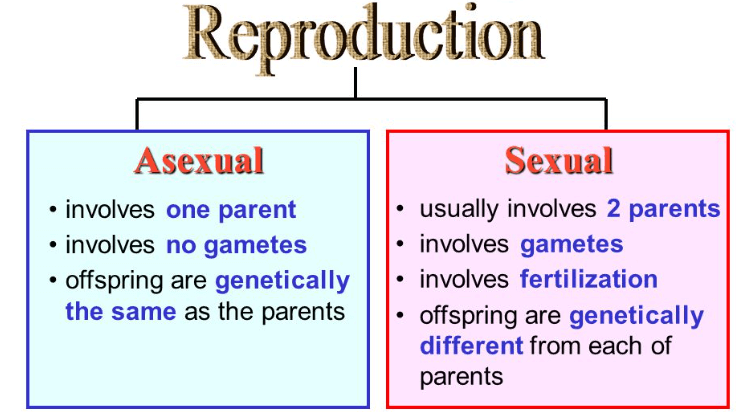
| Types of Reproduction | ||
| Type | Description | Examples |
| Sexual Reproduction | Involves the fusion of specialized sex cells (gametes) from two parents, resulting in genetically diverse offspring. | Humans, animals (e.g., dogs, cats), and most plants (e.g., roses, oak trees). |
| Asexual Reproduction | Involves the creation of offspring without the need for gametes or the involvement of another parent, resulting in genetically identical or similar offspring. | Bacteria (e.g., E.coli), some plants (e.g., strawberries, potatoes), and certain animals (e.g., starfish, jellyfish). |
Sexual Reproduction
Sexual reproduction is a biological process where two parent organisms contribute genetic material to create offspring. It involves the fusion of specialized cells called gametes, which are produced by each parent. Typically, a male parent produces small, mobile gametes (sperm), while a female parent produces larger, immobile gametes (eggs). When these gametes combine through fertilization, they form a zygote with a unique combination of genetic material from both parents. This genetic diversity enhances the adaptability and evolution of species.
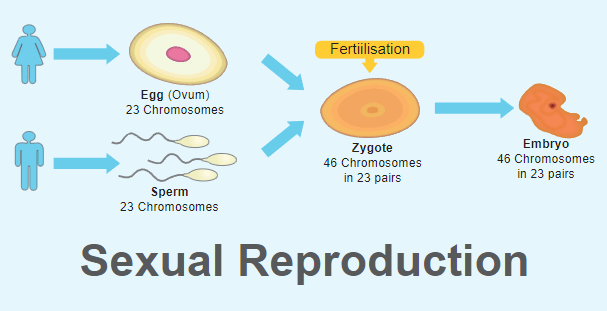
Advantages of Sexual Reproduction
The benefits of genetic diversity and the potential for improved availability make sexual reproduction an essential and advantageous strategy for many species.
- Genetic Diversity: Offspring inherit a combination of genes from both parents, increasing environments.
- Recombination: Genetic material from two parents allows for the repair of damaged DNA and the elimination of harmful mutations.
- Evolutionary Advantages: Variability enhances the chances of survival in a dynamic and competitive environment.
- Rapid Evolution: Genetic diversity accelerates the pace of evolutionary changes within a population.
Limitations of Sexual Reproduction
- Need for Mating: Finding a suitable mate can be time-consuming and challenging.
- Energy Costs: Sexual reproduction requires more energy due to the search for a mate and the production of specialized sex cells.
- Slow Reproduction: The process of mating, fertilization, and gestation is generally slower compared to asexual reproduction.
Asexual Reproduction
Asexual reproduction is another biological process in which offspring are produced, but in this process, the offspring are produced without the involvement of gametes (sperm and egg cells) or the fusion of genetic material from two parents.
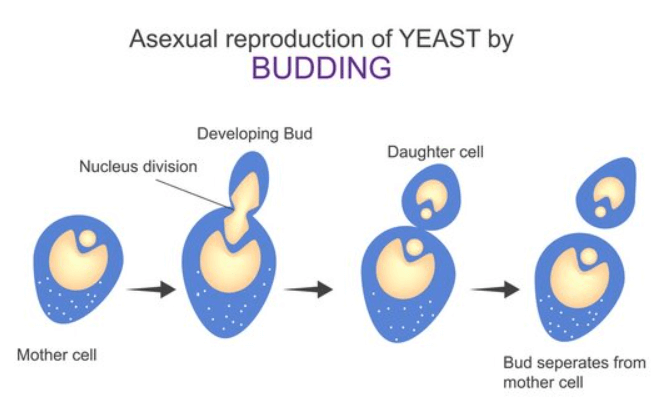
Instead, a single-parent organism gives rise to genetically identical or nearly identical offspring. Asexual reproduction can be advantageous in stable and favorable environments but may limit a species’ ability to respond to changing conditions over time. The asexual reproduction can occur through various mechanisms:
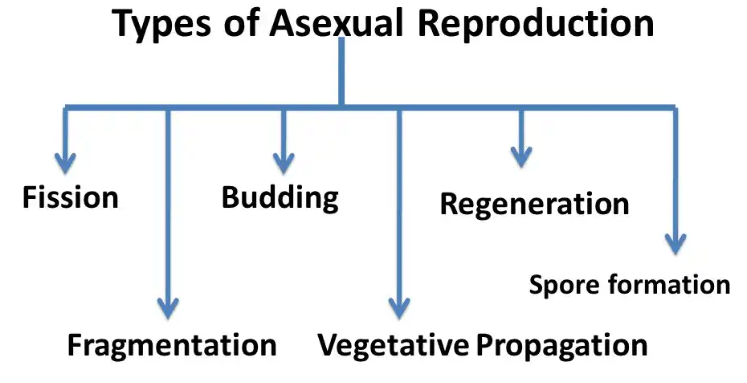
| Types of Asexual Reproduction | ||
| Types | Description | Examples |
| Binary Fission | The parent cell divides into two equal daughter cells. | Bacteria, amoebas. |
| Budding | A small outgrowth (“bud”) on the parent detaches to form a new individual. | Yeast, hydra. |
| Fragmentation | Parent organism breaks into fragments, each growing into a new organism. | Starfish, flatworms. |
| Vegetative Reproduction | New individuals develop from vegetative parts of the parent plant. | Strawberries (runners), potatoes (tubers). |
| Regeneration | Some organisms regrow lost body parts. | Lizards (regenerates its tail), Starfish(regenerates arms) |
| Spore Formation | Spore formation is a method of asexual reproduction in which specialized cells called spores are produced. | Mushrooms, ferns, bacteria, and mosses. |
Advantages of Asexual Reproduction
There are many advantages of asexual reproduction, some of which are mentioned below:
- Rapid Reproduction: Asexual reproduction can lead to rapid population growth since there is no need to find and attract a mate, and reproduction can occur quickly.
- Stable Traits: Offspring are genetically identical or very similar to parents, preserving advantageous traits. This is especially useful in stable environments.
- Energy Efficiency: Asexual reproduction requires less energy and resources compared to complex processes involving sexual reproduction.
Limitations of Asexual Reproduction
The process of asexual reproduction also involves several limitations.
- Lack of Genetic Diversity: Without genetic recombination, offspring are genetically identical, making them vulnerable to environmental changes and new challenges.
- Reduced Adaptability: In changing environments, asexual populations may struggle to adapt quickly due to their lack of genetic diversity.
- Accumulation of Harmful Mutations: Harmful mutations cannot be easily eliminated through genetic recombination, potentially leading to a buildup of detrimental traits.
Reproduction in Plants
Reproduction in plants involves the creation of new individuals through various mechanisms. These include sexual reproduction, where pollens from a flower’s male part fertilize the female part, leading to seed formation. Asexual reproduction involves the production of new plants. This diversity of reproduction strategies allows plants to adapt to different environments and ensure their survival.
Asexual Reproduction in Plants
Asexual reproduction in plants involves the creation of new individuals without the need for fertilization or the involvement of reproductive cells. Various methods are employed, including vegetative propagation, where a new plant grows from the roots, stems, or leaves of the parent plant. Runners, bulbs, corms, and tubers are examples of structures used for asexual reproduction. This process leads to genetically identical offspring, also known as clones.
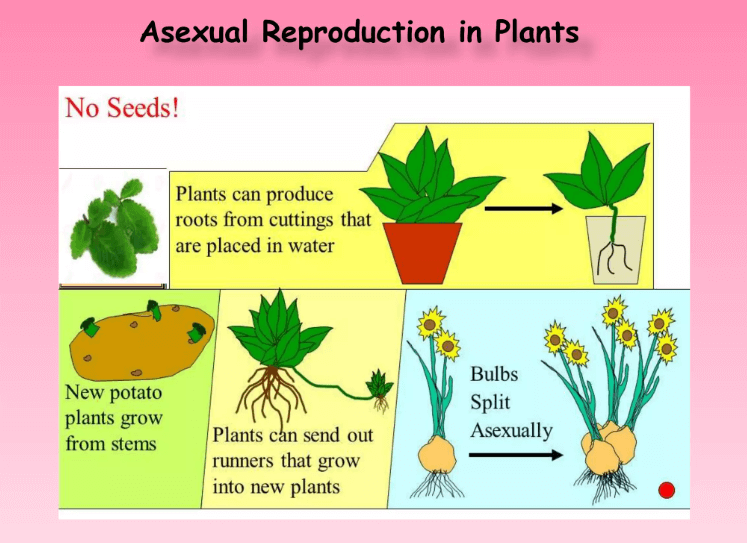
Sexual Reproduction in Plants
Sexual reproduction in plants involves the fusion of male and female reproductive cells, ensuring genetic diversity. The male part, the stamen, produces pollen-containing sperm cells, while the female pistil has the stigma, style, and ovary, housing ovules. Pollination, aided by wind, insects, or other agents, transfers pollen to the stigma.A pollen tube then grows down the style to the ovary, where fertilization occurs. Sperm fertilizes the egg, forming a zygote that becomes an embryo within a seed. The ovary develops into a fruit, protecting seeds and aiding their dispersal. This intricate process is essential for plant reproduction and survival.
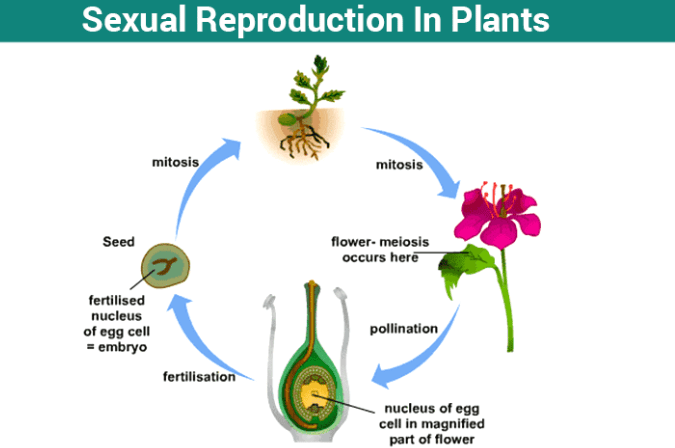
Reproduction in Animals
Reproduction in animals involves the creation of new offspring through different mechanisms. Sexual reproduction is the common method, where two parents contribute specialized reproductive cells (sperm and eggs) that fuse during fertilization to form a zygote. This zygote develops into an embryo and eventually a new organism. Sexual reproduction leads to genetic diversity, enabling adaptation to changing environments.
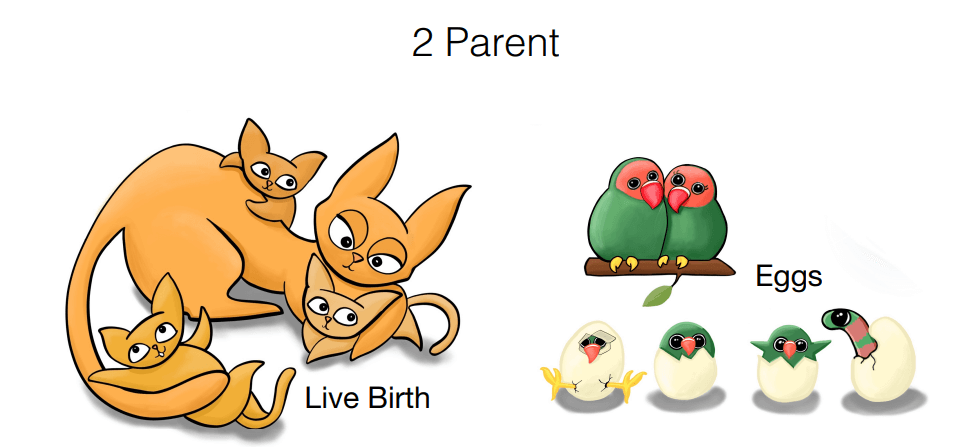
Asexual reproduction, seen in various animal species, involves the generation of offspring without fertilization. Methods included in asexual reproduction are binary fission (splitting into two), budding (new growth on the parent), and fragmentation (breaking into parts that grow into new organisms). While asexual reproduction is efficient, it doesn’t produce genetic diversity like sexual reproduction does. Both strategies contribute to the survival and diversity of animal species.
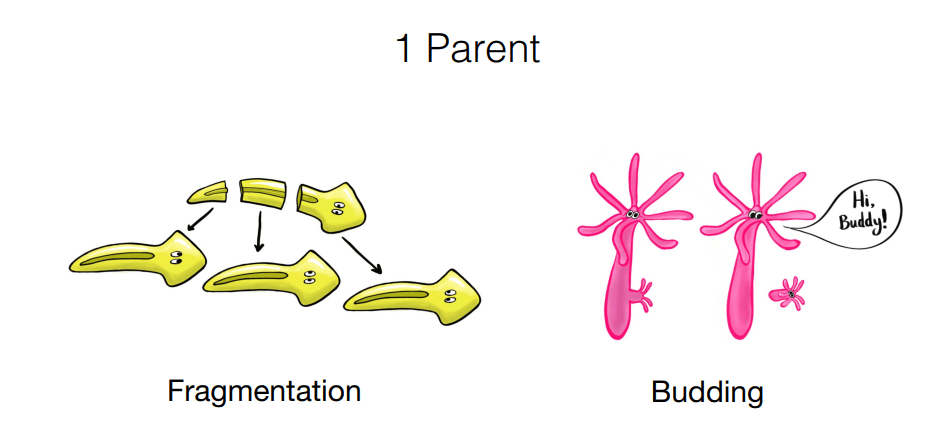

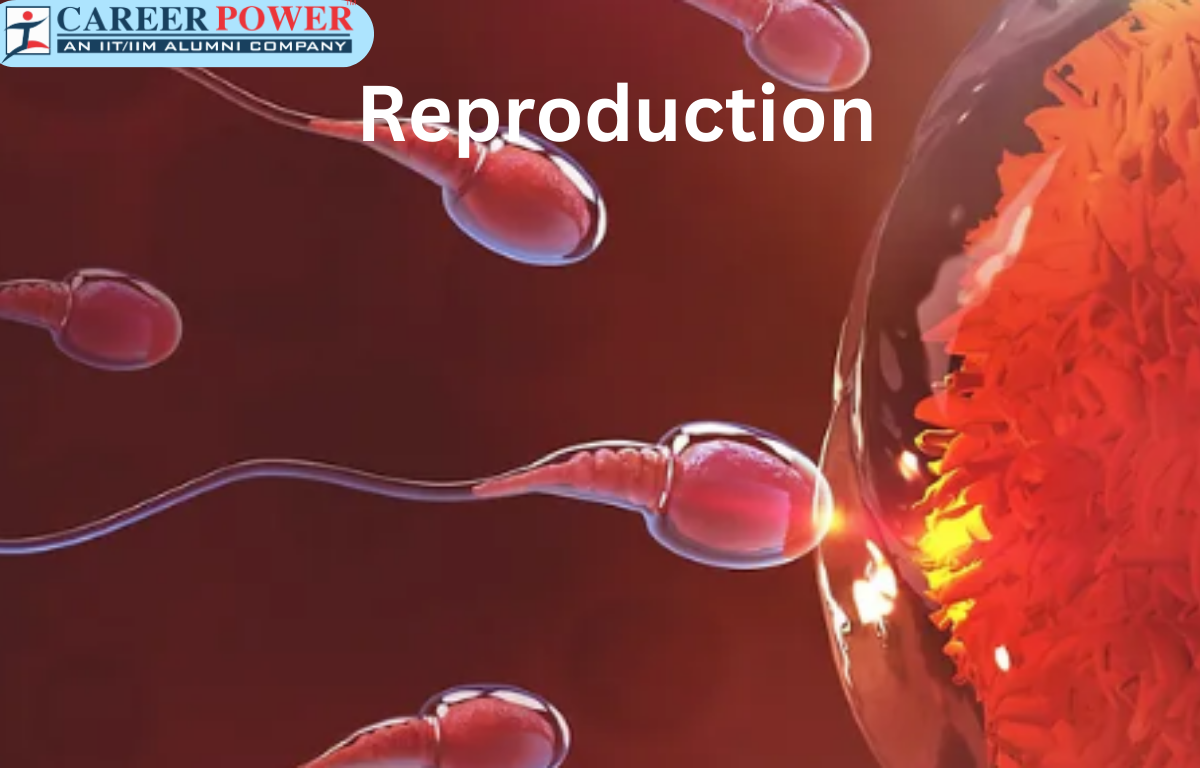

 50 Vegetables Name for Kids in English a...
50 Vegetables Name for Kids in English a...
 Food Chain: Definition, Types, Examples,...
Food Chain: Definition, Types, Examples,...
 Human Respiratory System: Definition, Di...
Human Respiratory System: Definition, Di...













